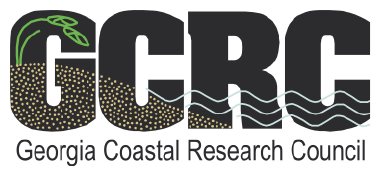The GCRC has been involved in coastal water quality issues since its inception in 2001.
Research Areas
Coastal Water Quality Indicators
We have compiled and analyzed coastal water quality dataset from several disparate Coastal Resources Division programs. As part of this analysis, we developed a framework for categorizing Georgia’s coastal water quality status based on seasonal and long-term trends.
Freshwater Inflow
A large body of our work concerns the effects of changing inflow on downstream resources and conditions. Please visit this section to see our projects and view a number of coastal water quality documents.
Watershed Assessments
Some of our most detailed studies were conducted on the Fort Pulaski National Monument and the Cumberland Island National Seashore with support by the National Park System. These substantial reports synthesized relevant data on coastal water quality to identify the key threats in the area. Since these parks are at the northern and southern extents of Georgia’s coastline and they are in markedly different realms with respect to development, they provide an interesting perspective on coastal water quality in our region.
Dissolved Nitrogen Concentrations in the Altamaha River Estuary
The Water Quality Analysis Simulation Program (WASP v.7.4) and a water flow model, SqueezeBox, were used to model concentrations of dissolved nitrogen in the Altamaha River estuary, Georgia.
Simulating Material Movement through the Lower Altamaha Estuary Using a 1-D Box Model
1-D optimum-boundary box models were used to simulate the movement of dissolved pollutants or other conservatively mixing constituents through the Altamaha River estuary. Tracers were introduced into the models as point sources at various locations within the estuary and as a non-point input to the entire system. In each case, models were run at four different river flow rates and were used to simulate both the movement of tracer within the estuary and its rate of removal.
Joan E. Sheldon and Merryl Alber. 2003. Simulating Material Movement through the Lower Altamaha Estuary Using a 1-D Box Model. Proceedings of the 2003 Georgia Water Resources Conference, April 23-24, 2003, University of Georgia. (ed.) Kathryn J. Hatcher.
Joan E. Sheldon and Merryl Alber – Poster presented at the Estuarine Research Federation meeting Nov. 4-8, 2001, St. Pete Beach, Florida.
Other Projects
Southeast Coastal Water Quality Monitoring
In 2008, the GCRC worked with the National Park Service to organize a metadata database that would compile information from water quality monitoring programs from the southeast. This link takes you to the database portal, a summary of the workshop leading to the formation of the database, and publications
Reports and Publications
Effects of Climate Signals on River Discharge to Ossabaw, St. Andrew, and Cumberland Sounds: Phase 1
Variability in precipitation and river discharge to the Ogeechee, Satilla, and St. Marys River estuaries (Georgia, USA) was examined in relation to indices for several climate signals and compared to earlier results for the Altamaha River estuary. Precipitation patterns in the watersheds were described using empirical orthogonal functions (EOFs) and were consistent across watersheds. We compared the time series (principal components, PCs) associated with these EOFs, monthly standardized anomalies of river discharge, and four climate indices: an index of the Bermuda High position (BHI), the Southern Oscillation Index (SOI, an index of El Niño and La Niña, also referred to as ENSO), the Atlantic Multidecadal Oscillation (AMO), and the North Atlantic Oscillation (NAO). The complex, seasonally alternating patterns that emerged were very similar across all watersheds.
Effects of Climate Signals on Shrimp and Crab Trawl Surveys in Ossabaw, St. Andrew, and Cumberland Sounds: Phase 2
We obtained fishery data from the Atlantic Coastal Cooperative Statistics Program and compared trawl catch rates with statewide catch per unit effort (CPUE) for four catch species. For available observations between 1986 and 2011, we found that the relationships between climate signal (Bermuda High Index, El Niño/Southern Oscillation Index, Atlantic Multidecadal Oscillation) patterns, precipitation, and river discharge that were revealed in the first phase of this analysis extended to salinity as well. We also found limited correlations of water temperature with climate signals, including correlations with the North Atlantic Oscillation, which did not show correlations with salinity or flow variables. Correlations between trawl catch and river discharge and salinity were limited and weak.
Deep Water Horizon Oil Spill Summit – Physical Oceanography (2010)
Deep Water Horizon Oil Spill Summit – Chemical Considerations (2010)
Herbicide Use near the Coastal Marshlands: Companion Document (2009)
State of Knowledge Report: Stormwater Ponds in the Coastal Zone (2007)
Stormwater Treatment in Coastal Areas (2007)
Impervious Surfaces: Review of Recent Literature (2006)
Marinas: Best Management Practices & Water Quality (2005)
Environmental Effects of Docks and Marinas, June 2005
Herbicide Use near the Coastal Marshlands (2005)
Water Quality in Georgia 2016-2017
The 2018 305(b)/303(d) Integrated Report for Georgia was prepared in accordance with Sections 305(b) and 303(d) of the Federal Clean Water Act and guidance from the U.S. Environmental Protection Agency. Here are the lists of Coastal Streams, Sounds & Harbors, and Coastal Beaches supporting / not supporting designated uses.
